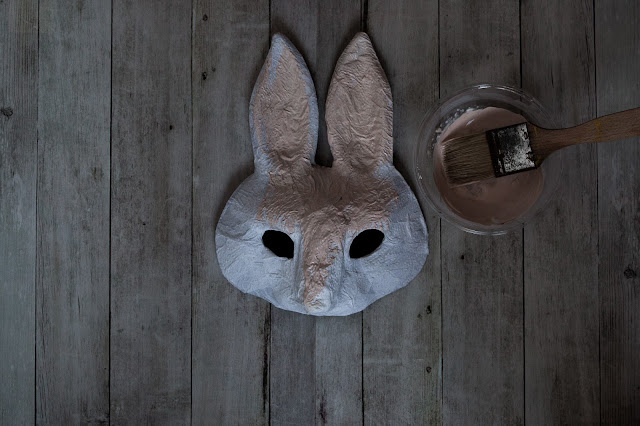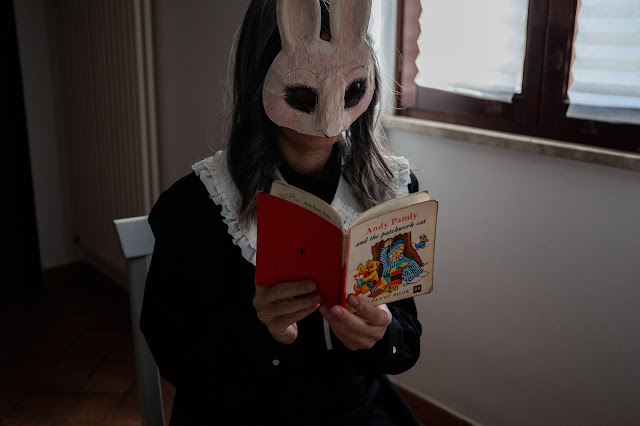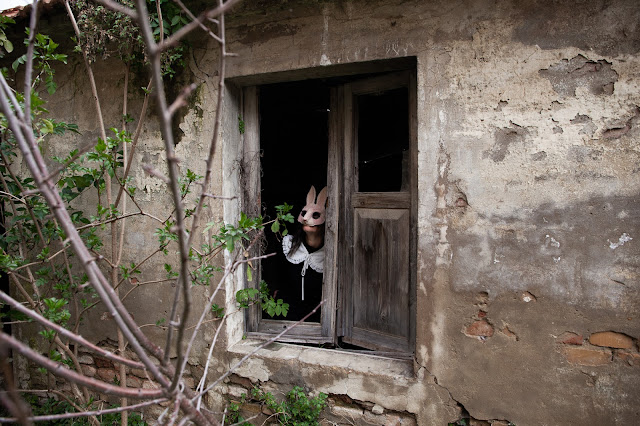"One day Mrs. Hollow got tired of having to adapt her face to every situation: to be happy, to be sad, to be bored, to get angry, or to console others. So she decided to make a face for herself. Finally, one face is ready for any emotion.
She took paper, glue, and brushes and built his new face.
Mrs. Hollow was so happy with her new face that she decided not to take it off again. Not even when she was home.
And when one day he got older, unfortunately, she no longer remembered how his real face once was.
It happens to many people as it does to her ".
I was inspired by the work of Brotherus who with "Portrait Series" pays homage to Baldessari's work on the subject of the artist's self-portrait while keeping the face hidden. Baldessari himself created a series of portraits of an artist with his face hidden by objects, arguing that the face could distract attention.
However, I inserted a face and I reconnected, in my research, to the work of Inge Morath "The Mask Series" with the artist Saul Steinberg, where through simple masks, designed by Steinberg, the accent is placed on how we wear social masks to adjust to expectations and mystify our true emotions.
So I imagined a small story taking a cue from Rodari's "Favole on the phone" by building a narrative like children's books where the protagonist does things: she dresses, reads, walks, leaves the house, goes into the woods (and here the work could go on).
In particular, I thought of Andy Pandy's stories that maybe I don't think are known in Italy, but when I was a child in the 70s he was very popular with us in Scotland.
The entry song of the show and the audiobooks said precisely "Andy Pandy is coming to play", which in my work has a double play value, but also to play a part, that is not to be yourself but to play another identity. Finally, "hollow" in English means "empty", which is a bit of the experience shared by those who feel the need to build an inauthentic identity to relate to themselves and to others.
Limited edition signed and numbered prints on fine art paper are available. If you require any further information, feel free to contact me at hello@margaretiris.com
(Italian)
"Un giorno Mrs.Hollow si era stufata di dover adattare la sua faccia ad ogni situazione: per essere felice, per essere triste, per essere annoiata, per arrabbiarsi o per consolare gli altri. Così decise di costruirsi una faccia da sé. Finalmente una faccia pronta per ogni emozione.
Prese carta, colla e pennelli e costruì la sua nuova faccia.
Mrs. Hollow era così felice della sua nuova faccia che decise di non togliersela più. Neanche quando era a casa.
E quando un giorno invecchiò purtroppo non si ricordava più com’era una volta la sua vera faccia.
A tanta gente succede come a lei".
In questo lavoro prosegue la mia indagine sul rapporto tra identità e corpo.
Ho preso ispirazione dal lavoro della Brotherus che con “Portrait Series” omaggia il lavoro di Baldessari sul tema dell’autoritratto dell’artista mantenendo però il viso nascosto. Baldessari stesso ha realizzato una serie di ritratti di artista con il volto nascosto da oggetti, sostenendo che il viso poteva distogliere l’attenzione.
Tuttavia io un volto l’ho inserito e mi sono ricollegata, nella mia ricerca, al lavoro di Inge Morath “The Mask Series” con l’artista Saul Steinberg, dove attraverso delle maschere semplici, disegnate da Steinberg, viene messo l’accento su come indossiamo maschere sociali per adeguarci alle aspettative e mistificare le nostre vere emozioni.
Quindi ho immaginato una piccola storia prendendo spunto da “Favole al telefono” di Rodari costruendo una narrazione come per i libri per bambini dove la protagonista fa cose: si veste, legge, passeggia, esce di casa, va nel bosco ( e qui il lavoro potrebbe proseguire).
In particolare ho pensato ai racconti di Andy Pandy che forse in Italia non credo sia conosciuto, ma quando ero bambina negli anni ‘70 era molto popolare da noi in Scozia.
La canzone di entrata dello show e degli audiolibri diceva appunto “Andy Pandy is coming to play”, che nel mio lavoro ha appunto una doppia valenza di gioco, ma anche di interpretare una parte, cioè non essere se stessi, ma recitare un’altra identità. Infine “hollow” in inglese vuol dire “vuoto”, che è un po’ il vissuto che accomuna coloro che sentono il bisogno di costruire un’identità inautentica per potersi relazionare con se stessi e con gli altri.
















